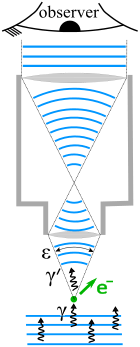Heisenberg's microscope
Heisenberg's microscope exists only as a thought experiment, one that was proposed by Werner Heisenberg, criticized by his mentor Niels Bohr, and subsequently served as the nucleus of some commonly held ideas, and misunderstandings, about Quantum Mechanics. In particular, it provided an argument for the uncertainty principle on the basis of the principles of classical optics. Recent theoretical and experimental developments have argued that Heisenberg's intuitive explanation of his mathematical result are misleading.[1][2] While the act of measurement does lead to uncertainty, the loss of precision is less than that predicted by Heisenberg's argument when measured at the level of an individual state. The formal mathematical result remains valid, however, and the original intuitive argument has also been vindicated mathematically when the notion of disturbance is expanded to be independent of any specific state.[3][4]
Heisenberg's argument

Heisenberg begins by supposing that an electron is like a classical particle, moving in the direction along a line below the microscope, as in the illustration to the right. Let the cone of light rays leaving the microscope lens and focusing on the electron make an angle with the electron. Let be the wavelength of the light rays. Then, according to the laws of classical optics, the microscope can only resolve the position of the electron up to an accuracy of[5]:21[6]
When an observer perceives an image of the particle, it's because the light rays strike the particle and bounce back through the microscope to their eye. However, we know from experimental evidence that when a photon strikes an electron, the latter has a Compton recoil with momentum proportional to , where is Planck's constant. It is at this point that Heisenberg introduces objective indeterminacy into the thought experiment. He writes that "the recoil cannot be exactly known, since the direction of the scattered photon is undetermined within the bundle of rays entering the microscope" . In particular, the electron's momentum in the direction is only determined up to[6]
Combining the relations for and , we thus have that[6]
- ,
which is an approximate expression of Heisenberg's uncertainty principle.
Problems with the argument
This thought experiment was formulated to help in introducing Heisenberg's Uncertainty Principle, which stands as one of the pillars of modern physics and as a theory that has been tested and confirmed countless times. That being said, the thought experiment has the somewhat unusual characteristic of attacking the premises under which it was constructed (Reductio ad absurdum), or at least of being involved in the development of an area of physics, quantum mechanics, that redefined the terms under which the original thought experiment was conceived. Quantum mechanics questions whether electrons actually have a determinate position before they are disturbed by the measurement that one might try to use to establish that they have such determinate positions. Under a more thorough quantum mechanical analysis, an electron has some probability of showing up at any point in the universe, but the probability that it will be far from where one might expect it to be becomes very low for places at great distances from the neighborhood in which it was originally found. In other words, the "position" of an electron can only be stated in terms of a probability distribution, and predictions of where it will move to can also only be given in terms of a probability distribution.
Footnotes
¹ Heisenberg, excerpt giving his own description of this thought experiment in The World of Mathematics, II, p. 1052.
Sources
- ↑ Lee A. Rozema; et al. (6 Sep 2012). "Violation of Heisenberg's Measurement-Disturbance Relationship by Weak Measurements". Phys. Rev. Lett. 109 (18): 189902. doi:10.1103/PhysRevLett.109.100404.
- ↑ "Scientists cast doubt on Heisenberg's uncertainty principle". Science Daily. 7 Sep 2012.
- ↑ Paul Busch; Pikka Lahti; Richard Werner (Oct 2013). "Proof of Heisenberg's error-disturbance relation". Physical Review Letters. 111 (16): 160405. doi:10.1103/PhysRevLett.111.160405.
- ↑ Lett, Caron (17 Oct 2013). "Scientists prove Heisenberg's intuition correct". University of York.
- ↑ Werner Heisenberg (1949). The Physical Principles of the Quantum Theory. Courier Dover Publications. ISBN 978-0-486-60113-7.
- 1 2 3 Richmond, Michael. "Heisenberg's Microscope". Retrieved 1 Sep 2016.
- Amir D. Aezel, Entanglement, pp. 77–79.
- Niels Bohr, Nature, 121, p. 580, 1928.
- Werner Heisenberg, Physics and Philosophy, pp. 46ff.
- Albert Messiah, Quantum Mechanics, I, p. 143f
- James R. Newman, ed., The World of Mathematics, II, pp. 1051–1055
External links
See also
- Quantum mechanics
- Basics of quantum mechanics
- Interpretation of quantum mechanics
- Philosophical interpretation of classical physics
- Schrödinger's cat
- Uncertainty principle
- Quantum field theory
- Electromagnetic radiation